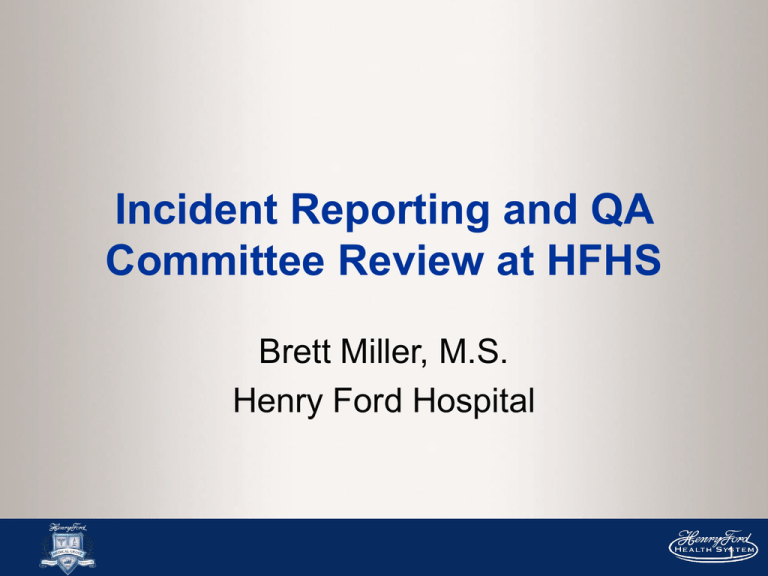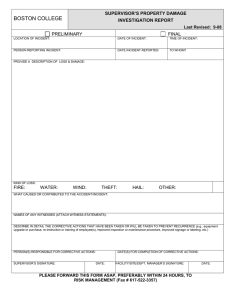Incident Reporting and QA Committee Review at HFHS Brett Miller, M.S.
advertisement

Incident Reporting and QA Committee Review at HFHS Brett Miller, M.S. Henry Ford Hospital 1 Disclosures Henry Ford Health System has a research agreement with Varian Medical Systems Travel reimbursement and honorarium from Varian Medical Systems 2 Outline A Culture of Patient Safety HFHS In-house Incident Learning System QA Committee Review – Gather information. What? How? Why? – Develop plan of corrective action Summary Motivation/Sources of Errors 4 What can we do? Foster a Culture of Patient Safety Develop thorough QA policies and procedures – Develop Process Maps, identify Failure Modes, use Root Cause Analysis (RCA) and Failure Mode and Effects Analysis (FMEA) – Incident learning – Continually update through program review – Review vendor CTB’s and product recalls Learn from experts 5 What can we do? Foster a Culture of Patient Safety Develop thorough QA policies and procedures – Develop Process Maps, identify Failure Modes, use Root Cause Analysis (RCA) and Failure Mode and Effects Analysis (FMEA) – Continually update through program review – Incident learning – Review vendor CTB’s and product recalls Learn from experts 6 Culture of Patient Safety Start at the top – Every process needs a leader who must lead by example – Everyone, including the leader, must look at their work with a critical eye 7 Work as a Team Accountability without blame Policies and Procedures Measurement of Quality Culture of Patient Safety Start at the top Work as a Team – Therapist, Dosimetrist, Physicist, Physician, Nurse, IT Professionals, Administrators – Remove Hierarchy – Anyone on the team can prevent an error – Every member of the team needs to have the appropriate tools, training and time to do their job correctly – Communication; Flow of Information Accountability without blame Policies and Procedures Measurement of Quality 8 Culture of Patient Safety Start at the top Work as a Team Accountability without blame – Talk about errors as a learning experience – Must be a non-punitive, nurturing environment where individuals are held accountable Policies and Procedures Measurement of Quality 9 Culture of Patient Safety Start at the top Work as a Team Accountability without blame Policies and Procedures – Clear, consistent and thorough – Mandate delay of treatment if not safe – Continually updated and modified with feedback from staff and monitoring of reported incidents – Review of incidents when policies are not followed Measurement of Quality 10 Culture of Patient Safety Start at the top Work as a Team Accountability without blame Policies and Procedures Measurement of Quality – Incident Reporting and Error Analysis – Key Quality Indicators/Key Performance Indicators 11 Incident Reporting System Workflow Report Entered Potential Dose Consequence Dosimetry Review Physician Review Process Improvement pre-QAC Review Good Catch Potential Policy Change QAC Review Dosimetry Sign Off QAC Review Reports submitted at any of our 5 sites via the intra-department website. Reviewed by leads (physician, physicist and therapist) at each site. – Keeps leaders informed – Distributes workload – Allows for information gathering prior to QAC meeting Reviewed on a monthly basis by QAC. QAC Review Review Selected Incident Reports Review Statistics Looking for Trends – By site – By category Identify “Good Catches” Discuss Policy Updates Open Discussion QAC Review - Statistics Site/ Category Category 1 Category 2 Category 3 Other Site 1 Site 2 Site 3 Site 4 Site 5 Totals Root Cause Analysis Gather information about the event – Must be done in a non-punitive manner – accountability needs to exist – Buy in from entire department Develop a process map Look for cause and effect relationships Identify holes in your clinical process Root Cause Analysis Process Step – Identify where the incident occurred Failure Mode – Collect information on what happened Failure Pathway – How and why did it happen? Develop a plan of corrective action FMEA – RPN calculated prior to and after corrective action FMEA and Deming Cycle Implement change: Decrease the probability the incident will reoccur Increase the probability of detecting the incident Severity remains unchanged Hierarchy of Effectiveness Most Useful Interlocks/ Forcing Functions Tech Focus Automation Simplify/Standardize Checklists, reminders, double checks Policies and Procedures Training and Education 21 Institute for Safe Medical Practices, 1999 People Focus Least Useful Example - RCA Failure Mode: Couch model inserted into the plan but at the incorrect location Discussed with dosimetry and physics to determine why couch model was inserted incorrectly. Failure Pathway – New clinical process – Inadequate checklists Example – Corrective Action Failure Mode: Couch model inserted into the plan but at the incorrect location Additional checklist items related to the couch insertion Update policies and procedures Staff education Example – Wiki Page Example – Wiki Page Example – Wiki Page Example – Staff Update Vendor Customer Technical Bulletins Information from vendors to identify areas of weakness previously not known by the end user. When you receive a Custom Technical Bulletin (CTB) from a vendor it will have several components: – Description of the issue – User recommended corrective action – Vendor corrective action Need to understand how YOUR CLINIC’S WORKFLOW is affected by each bulletin Summary Develop a Culture of Patient Safety Develop and use an Incident Learning System QAC Review – RCA, FMEA – PDSA cycle Feedback to Staff 29 Thank You Ben Movsas, MD. Department Chair Indrin Chetty, PhD. Physics Division Chief Salim Siddiqui, MD, PhD. QAC Chair Michelle Dickinson, BS RT(T). QA Therapist etc. What are ways we can improve quality and safety in radiation therapy? 1% 1% 0% 0% 99% 1. 2. 3. 4. 5. Encourage research on quality Educate leadership Collaborate with vendors Adopt a patient view on quality All of the above What are ways we can improve quality in radiation therapy? 1. 2. 3. 4. 5. All of the above Pawlicki and Mundt, Med. Phys. 34 (2007) 1529-1534 FMEA… 1. Focuses on the entire process 2. Calculates a single RPN for all failure modes 3. Requires understanding of the process 4. Calculates a RPN which is an absolute measure of risk 5. According to TG-100, is useless 45% 34% 10% 8% 4% 1. 2. 3. 4. 5. FMEA… 1. 2. 3. Requires understanding of the process 4. 5. Huq, et al. IJROBP 71 (2008) S170-S173 Ford, et al. IJROBP 74 (2009) 852-858 A culture of patient safety… 62% 1. Does not require effective communication between staff members 2. Ensures only physicists are active in improving the clinical process 3. Is punitive when responding to reported incidents 4. Utilizes human factors engineering 29% 5. Utilizes an informal QA Committee 2% 4% 4% A culture of patient safety… 1. 2. 3. 4. Utilizes human factors engineering 5. ASTRO “Safety is No Accident” (2012)

